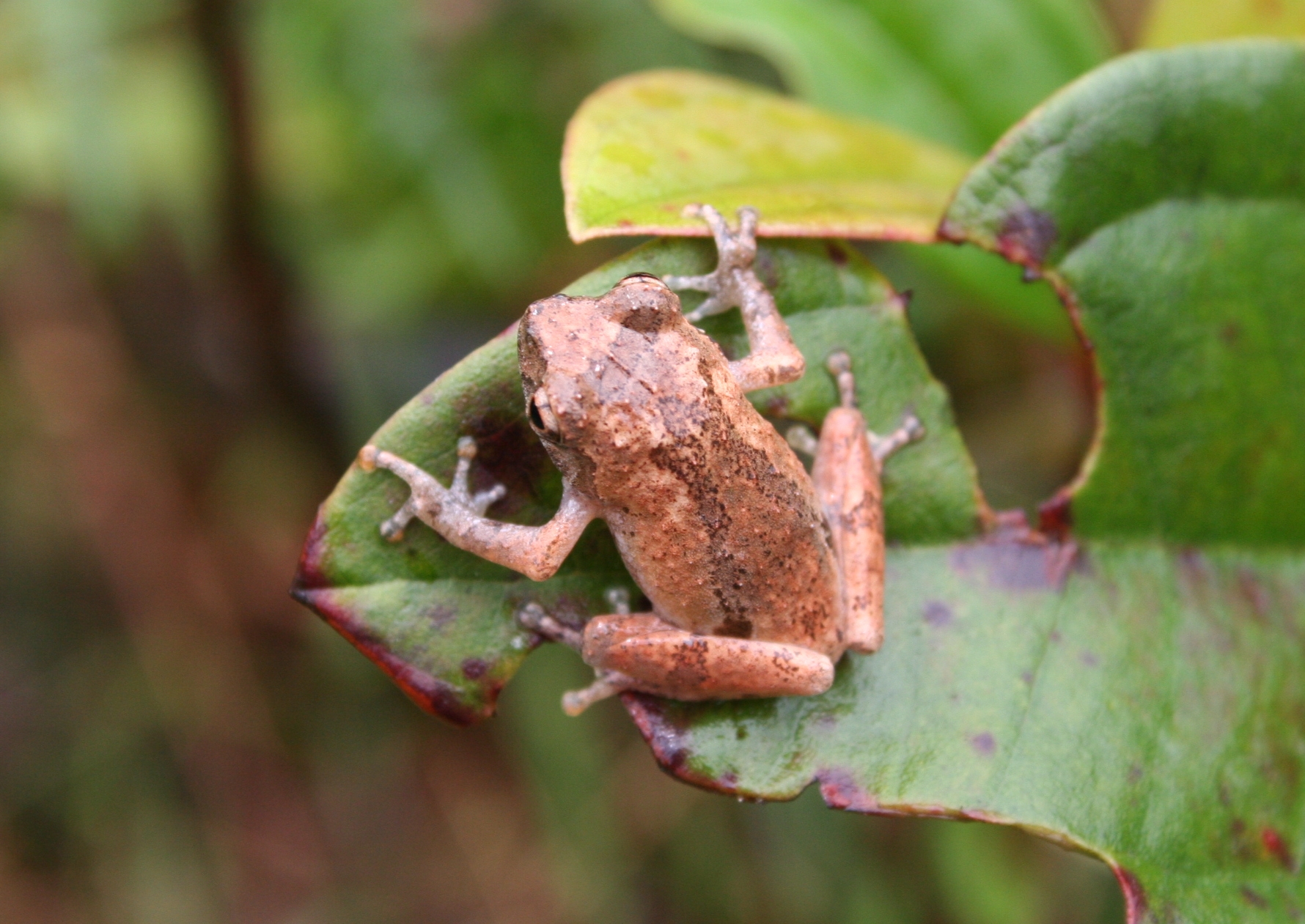| Citation |
IUCN SSC Amphibian Specialist Group 2016. Philautus cardamonus. The IUCN Red List of Threatened Species 2016: e.T58826A85539866. http://dx.doi.org/10.2305/IUCN.UK.2016-3.RLTS.T58826A85539866.en. Downloaded on 08 May 2019. |
Description |
Geographic Range
NATIVE
Extant (resident)
Cambodia
NUMBER OF LOCATIONS
1
UPPER ELEVATION LIMIT
1,650 metres
LOWER ELEVATION LIMIT
1,100 metres
Geographic Range in detail
ESTIMATED AREA OF OCCUPANCY (AOO) (KM²)
CONTINUING DECLINE IN AREA OF OCCUPANCY (AOO)
EXTREME FLUCTUATIONS IN AREA OF OCCUPANCY (AOO)
ESTIMATED EXTENT OF OCCURRENCE (EOO) (KM²)
1775
CONTINUING DECLINE IN EXTENT OF OCCURRENCE (EOO)
EXTREME FLUCTUATIONS IN EXTENT OF OCCURRENCE (EOO)
CONTINUING DECLINE IN NUMBER OF LOCATIONS
EXTREME FLUCTUATIONS IN THE NUMBER OF LOCATIONS
RANGE DESCRIPTION
This species is currently known only from 1,100-1,650 m asl in Phnom Samkos Wildlife Sanctuary, Pursat Province, in the Cardamom Mountains of Cambodia (Ohler et al. 2002). This is unlikely to represent the actual limits of the species range as similar habitat and elevations to those in its known locality occur in adjacent parts of Battambang and Koh Kong Provinces. Further surveys in these areas may uncover its presence there, though it is possible that this montane species capacity for dispersal is limited by intervening lowland areas. The species extent of occurrence (EOO) is 1,775 km2 and represents only one threat-defined location.
Population
CURRENT POPULATION TREND
Unknown
NUMBER OF MATURE INDIVIDUALS
POPULATION SEVERELY FRAGMENTED
CONTINUING DECLINE OF MATURE INDIVIDUALS
Population in detail
EXTREME FLUCTUATIONS
NO. OF SUBPOPULATIONS
CONTINUING DECLINE IN SUBPOPULATIONS
EXTREME FLUCTUATIONS IN SUBPOPULATIONS
ALL INDIVIDUALS IN ONE SUBPOPULATION
NO. OF INDIVIDUALS IN LARGEST SUBPOPULATION
DESCRIPTION
No information is known about the size or trends of this species population except that it has only been detected in four surveys (Ohler et al. 2002, Grismer et al. 2008, Thy Neang pers. comm. December 2015). No evidence for population declines has been found (Thy Neang pers. comm. December 2015).
Habitat and Ecology
SYSTEM
Terrestrial
HABITAT TYPE
Forest
GENERATION LENGTH (YEARS)
CONGREGATORY
MOVEMENT PATTERNS
Not a Migrant
CONTINUING DECLINE IN AREA, EXTENT AND/OR QUALITY OF HABITAT
Yes
Habitat and Ecology in detail
HABITAT AND ECOLOGY
This species is associated with montane evergreen forest (Ohler et al. 2002). It has been observed on vegetation both near streams and away from water (Ohler et al. 2002). This species reproductive biology is not well known, however it may breed by direct development as do many closely related species for which the reproductive strategy is known. Research is warranted to determine its oviposition behaviour as this varies among the genus and is not known for this species. The quality of habitat adjacent to the species range is in decline due to logging (Ohler et al. 2002, Bradfield and Daltry 2009), however, these processes appear to be limited to lower elevations (Thy Neang pers. comm. December 2015).
CLASSIFICATION SCHEME
Habitats Suitability Major importance
1. Forest 1.9. Forest - Subtropical/Tropical Moist Montane Suitable Yes
Threats
Energy production & mining
Mining & quarrying
Biological resource use
Logging & wood harvesting
Natural system modifications
Dams & water management/use
Threats in detail
THREATS
A high rate of forest loss has been identified as a significant threat to biodiversity throughout Cambodia (Sodhi et al. 2009). A major cause of habitat loss in the Cardamom Mountains (including within Phnom Samkos Wildlife Sanctuary) is the illegal removal of certain tree species for the harvest and refinement of safrole oil - a precursor to the production of elicit narcotics including methylenedioxymethamphetamine (known commonly as ecstasy). This species type-locality is described as affected by logging (Ohler et al. 2002), however the majority of its range is at higher elevations where this has little effect, and in some areas logging has ceased (Thy Neang pers. comm. December 2015). There are proposals for dams, mines and logging in and around protected areas in south-western Cambodia, which are expected to have some negative impacts on this species population and the quality of its habitat (J. Rowley pers. comm. December 2015).
CLASSIFICATION SCHEME
Threats Timing Stresses Scope Severity Impact score Invasive species Virus
3. Energy production & mining 3.2. Mining & quarrying Future
1. Ecosystem stresses 1.1. Ecosystem conversion
1.2. Ecosystem degradation
2. Species Stresses 2.1. Species mortality
2.2. Species disturbance
Unknown Unknown Unknown
5. Biological resource use 5.3. Logging & wood harvesting 5.3.3. Unintentional effects: (subsistence/small scale) [harvest] Ongoing
1. Ecosystem stresses 1.1. Ecosystem conversion
1.2. Ecosystem degradation
2. Species Stresses 2.2. Species disturbance
Unknown Unknown Unknown
5.3.4. Unintentional effects: (large scale) [harvest] Ongoing
1. Ecosystem stresses 1.1. Ecosystem conversion
1.2. Ecosystem degradation
2. Species Stresses 2.1. Species mortality
2.2. Species disturbance
Unknown Unknown Unknown
7. Natural system modifications 7.2. Dams & water management/use 7.2.10. Large dams Future
1. Ecosystem stresses 1.1. Ecosystem conversion
1.2. Ecosystem degradation
2. Species Stresses 2.1. Species mortality
2.2. Species disturbance |

